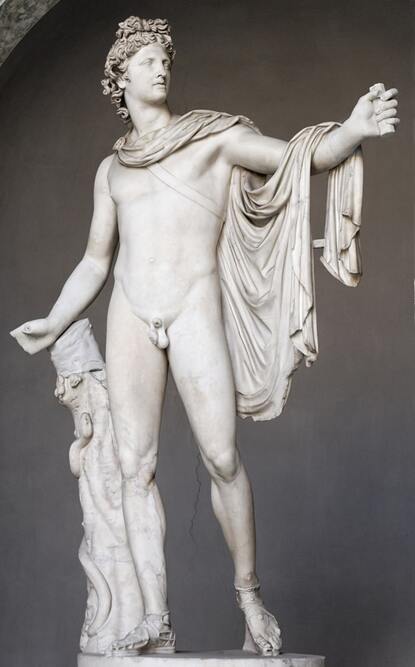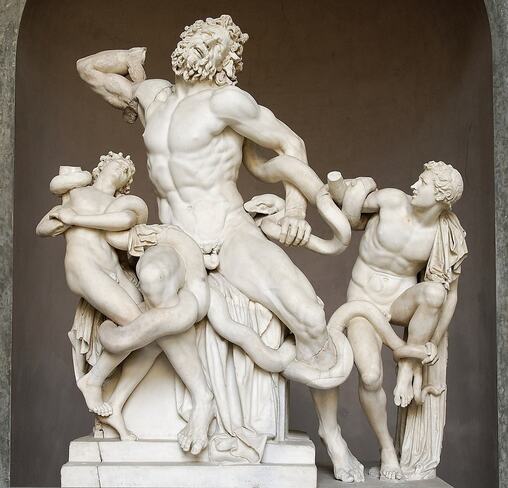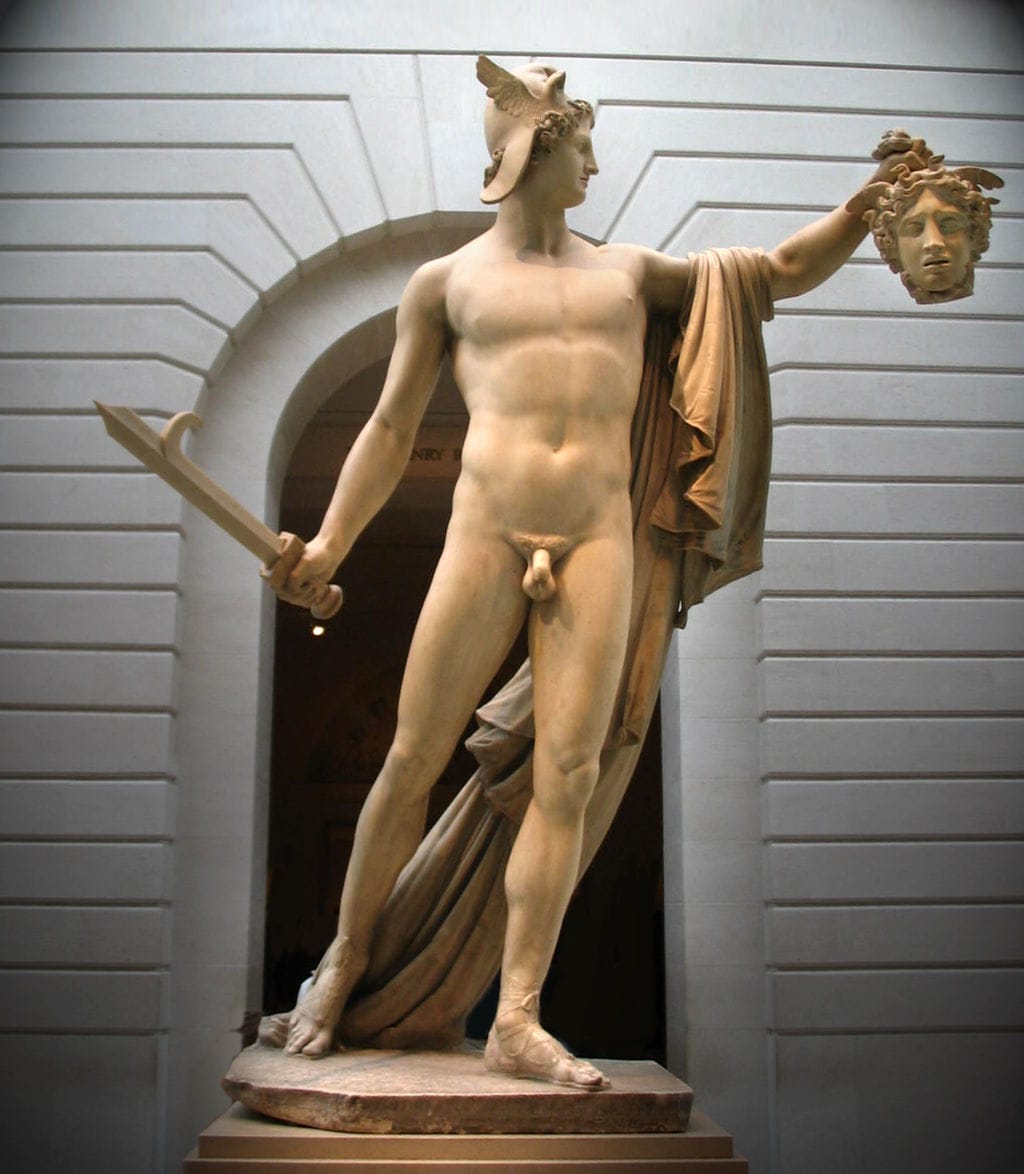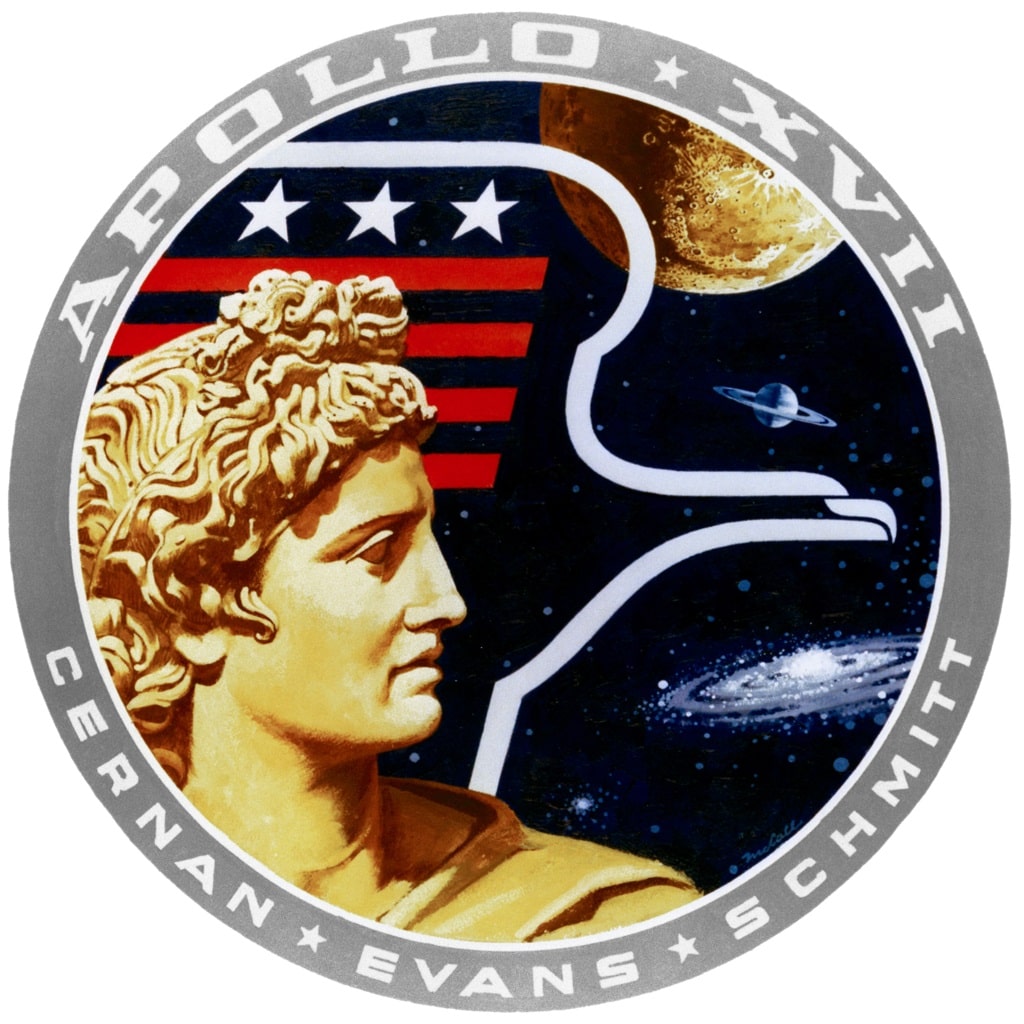|
Where? The Octagonal Court of the Museo Pio Clementino in the Vatican Museums
When? Probably between 117 and 138 AD What do you see? A marble statue of 88 inches (2.24 meters) of a beardless, athletic Apollo. The surface of the statue is very smooth. Apollo’s face shows a neutral expression. He steps forward a bit with his right leg and throws back his cloak over his left shoulder to show his fully naked body. He looks to his left and has his left arm stretched out to support his cloak. Apollo has beautiful curly hair. His hair is tied on the top with a band and his curls hang down his neck. Around his torso, he is wearing a quiver to hold his arrows. He is also wearing sandals. On the left side (for the viewer), the statue is supported by a tree trunk, and you can see a snake carved on the left side of the tree. It is not entirely clear what mythological story is depicted in this statue, though it is suggested that Apollo originally was carrying a bow and arrow. This pose may represent Apollo who has just released an arrow with the bow that he was holding in his left hand. Some people suggest that this statue represents the moment that Apollo has just killed the serpent (which is a dragon) Python. The snake on the left, which may be a python, may serve as additional evidence to support this story. Backstory: This statue has been discovered in the 15th century and is also known as the Pythian Apollo. It was probably found around 1485 in Anzio, which is about 35 miles south of Rome. This statue is a Roman copy of an ancient Greek bronze statue. It is unknown who sculpted the current version of the statue. Leochares may have sculpted the original bronze statue in the 4th century BC. Originally, the right forearm and left hand of the Apollo Belvedere were missing, but they have been restored around 1532 by Giovanni Angelo Montorsoli (a pupil of Michelangelo). Near the end of the 15th century, the statue has been acquired by Giuliano della Rovere, a great art collector, who became later Pope Julius II. The statue has been named after the Belvedere Court in the Vatican Museums where the statue was placed in 1511. It has stayed there since then, except for a period of almost 20 years when Napoleon took it and displayed in Paris. Thanks to the efforts of, among others, Antonio Canova, the statue returned to its original location. The Octagonal Court: The Octagonal Court is currently part of the Vatican Museums. The court has been designated by Pope Julius II (1503-1513) to display antique classical statues. It is an open-air court containing several famous statues from antiquity. Its name is derived from the octagonal shape of the court and was given by Pope Clement XIV in 1772. Shortly after that, the court was incorporated in the Vatican Museums and opened to the public. The Apollo Belvedere and the statue of Laocoön and His Sons are the most famous statues in this court, and both have been there from the beginning.
Who is Apollo? Apollo is the god of, among others, archery, art, music, and poetry. He is the son of Zeus and Leto and the twin sister of Artemis. In Greek mythology, he is considered to be the most beautiful man that can be imagined. A bow and arrows are his most important attributes to represent his role as the god of archery. He received these attributes from Hephaestus, the blacksmith for the gods.
However, in this statue, there are no bow and arrows, though he is wearing a quiver that usually contains arrows. He probably held the bow in his left hand. You can still see a small part of the bow in his hand, but the rest of the bow was lost before the statue was discovered. Copies and inspiration: The Apollo Belvedere has for a long time been considered as the ideal depiction of male beauty. It has been copied many times and has served as an inspiration for many future artists. For example, artists such as Michelangelo and Dürer have used it as an inspiration for their sketches and sculptures. This statue also had a big influence on the Neoclassical sculptors, such as Antonio Canova. For example, his statue of Perseus with the Head of Medusa has been directly inspired by the Apollo Belvedere. The head of the Apollo Belvedere has also been used for the emblem of the Apollo 17 lunar landing mission in 1972, which has been the last moon landing mission to date.
Fun fact: Johann Winckelmann is a famous art historian, and in his book History of Ancient Art, he poetically describes ancient art. His book also contains a description of the Apollo Belvedere. He classified the Apollo Belvedere as “the highest ideal of art” among all classic works that have survived. He classifies this statue as a beauty that transcends the beauty that we can find in this world. He admits that his words can never describe the beauty of this sculpture and looking at the statue transfers his mind to an earthly paradise.
Written by Eelco Kappe
References:
0 Comments
Leave a Reply. |
Categories
All
|
- Home
- Blog
-
Museums
- Alte Pinakothek
- Art Institute of Chicago
- Baltimore Museum of Art
- Barber Institute of Fine Arts
- Bargello
- Barnes Foundation
- British Museum
- Church of Sant’Anastasia
- Cleveland Museum of Art
- Courtauld Institute of Art
- Detroit Institute of Arts
- Frans Hals Museum
- Galleria Borghese
- Gallerie dell'Accademia
- Getty Museum
- Guggenheim
- Hermitage Museum
- Kunsthistorisches Museum
- Kunstmuseum Basel
- Legion of Honor Museum
- Louvre
- Mauritshuis
- Metropolitan Museum of Art
- Musee d’Orsay
- Museum of Fine Arts in Boston
- Museum of Modern Art
- National Gallery in London
- National Gallery of Art
- National Museum in Poznań
- Norton Simon Museum
- Ny Carlsberg Glyptotek
- Palace of Versailles
- Palazzo Pitti
- Palazzo Vecchio
- Petit Palais
- Philadelphia Museum of Art
- Prado
- Pushkin Museum
- Ravenna Art Museum
- Rijksmuseum
- San Diego Museum of Art
- Santa Maria delle Grazie
- St. Peter's Basilica
- Städel Museum
- Statens Museum for Kunst
- Tate Britain
- Tate Modern
- Timken Museum of Art
- Uffizi
- Vatican Museums
- Wallace Collection
-
Artists
- Altdorfer
- Anguissola
- Berlin Painter
- Bosch
- Botticelli
- Boucher
- Bronzino
- Bruegel the Elder
- Brunelleschi
- Cabanel
- Caillebotte
- Canova
- Caravaggio
- Carpeaux
- Cezanne
- Cimabue
- David
- Degas
- Delacroix
- De Maria
- Donatello
- El Greco
- Fontana
- Fra Angelico
- Fragonard
- Gauguin
- Gentileschi
- Gericault
- Gonzalez-Torres
- Goya
- Hals
- Hogarth
- Hokusai
- Ingres
- Leonardo da Vinci
- Lippi, Filippo
- Longhi, Barbara
- Lorrain
- Makovsky
- Manet
- Massys
- Matisse
- Merian
- Michelangelo
- Mochi
- Modigliani
- Monet
- Panini
- Parmigianino
- Perugino
- Picasso
- Pisanello
- Raphael
- Rembrandt
- Renoir
- Reynolds
- Rivera
- Rodin
- Rubens
- Scultori
- Seurat
- Steen
- Tintoretto
- Titian
- Toulouse-Lautrec
- Turner
- Uccello
- Van der Weyden
- Van Dyck
- Van Eyck
- Van Gogh
- Van Hemessen
- Vasari
- Velazquez
- Vermeer
- Veronese
- Vigée Le Brun
-
Locations
- Books
- About Us




